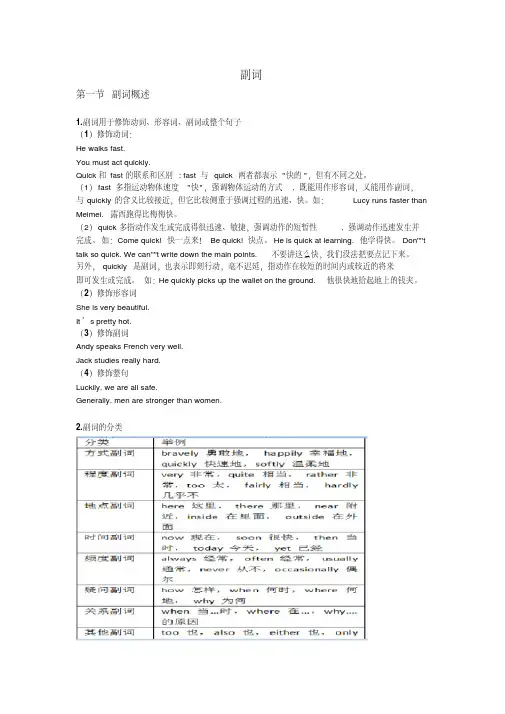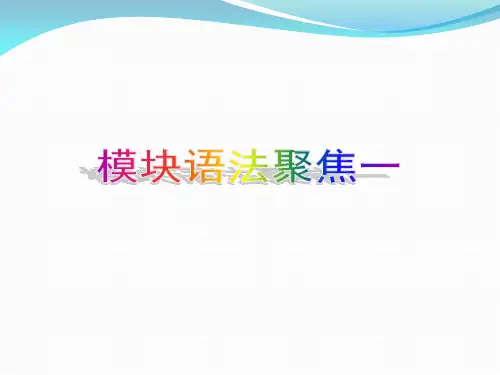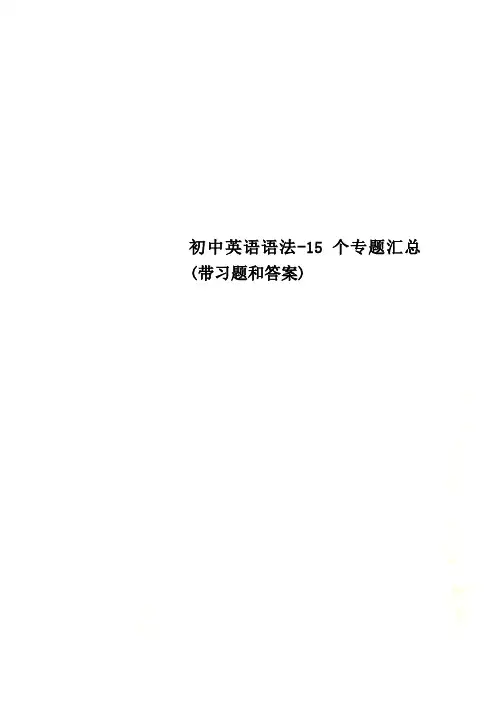初中英语语法专题
初中英语语法专题-副词(附练习答案)

副词第一节副词概述1.副词用于修饰动词、形容词、副词或整个句子(1)修饰动词:He walks fast.You must act quickly.Quick和fast的联系和区别: fast 与quick 两者都表示"快的",但有不同之处。
(1)fast多指运动物体速度"快",强调物体运动的方式, 既能用作形容词,又能用作副词,与quickly的含义比较接近,但它比较侧重于强调过程的迅速、快。
如:Lucy runs faster than Meimei. 露西跑得比梅梅快。
(2)quick多指动作发生或完成得很迅速、敏捷,强调动作的短暂性, 强调动作迅速发生并完成。
如:Come quick! 快一点来!Be quick! 快点。
He is quick at learning. 他学得快。
Don''''t talk so quick. We can''''t write down the main points. 不要讲这么快,我们没法把要点记下来。
另外,quickly是副词,也表示即刻行动,毫不迟延,指动作在较短的时间内或较近的将来即可发生或完成。
如:He quickly picks up the wallet on the ground. 他很快地拾起地上的钱夹。
(2)修饰形容词She is very beautiful.It’s pretty hot.(3)修饰副词Andy speaks French very well.Jack studies really hard.(4)修饰整句Luckily, we are all safe.Generally, men are stronger than women.2.副词的分类第二节副词的构成和比较等级1.形容词构成副词的一般规则有些形容词和副词同形,如:back adj. 后面的back adv. 向后地2.副词的比较等级(1)单音节词,加-er和-est(2)双音节词及多音节词,加more 和most但是early 的比较级和最高级则分别为:earlier earliest (3)不规则变化的词farther/ farthest, further /furthest的用法farther/ farthest和further /furthest都可用于表示距离和时间上的远We can go farther/further.We can look back farther/further into the past to find the truth.further /furthest 还可表示程度上的“深远”“进一步”The police will research further into this matter.3.原级比较常用句型,,as+副词原级+as,.该句型表示:,.和,..一样He speaks as loudly as you do.,.not as (so)+副词原级+as...该句型表示:,..不如,..I can’t walk as/so fast as you.他没有你反应的快。
初中英语语法专题---感官动词(共15张PPT)

模块语法聚焦一
( )11.—Do you like swimming in winter? —Of course. The water ________ a bit cold at first, but then I am warm and full of energy. A.tastes B.feels C.smells D.looks ( )12.Mum is making dinner. It ________ so nice! A.smells B.tastes C.feels D.sounds
He looks tired.
他看起来累了。
These flowers smell sweet.
这些花闻起来香。
模块语法聚焦一
Her voice sounds beautiful. 她的声音听起来优美。 The cake tastes delicious.蛋糕尝起来美味。 I felt guilty.我感到内疚。 3.感官动词后可接介词like, like后可接名词或v.ing 形式。例如: That boat looks like a duck. 那条船看起来像一只鸭子。 It smells like being burnt.它闻起来像烧焦了一样。
[答案] 13D,14C,15C
模块语法聚焦一
Ⅱ.根据汉语意思完成句子 1.我的毛衣摸起来柔软。 My sweater ___f_e_e_l_s_s_o__ft_. 2.聚会听起来太吵了。 The party __s_o_u_n_d_s__n_o_i_s_y_______. 3.你妈妈看上去很年轻。 Your mother _____L_o_o_k_s__y_o_u_n_g_______. 4.汤尝起来咸了。 The soup ____T_a_s_t_e_s__s_a_l_t_y____. 5.它闻起来新鲜吗? __D_o_e_s__ it __s_m_e_l_l___f_r_e_s_h__?
初中英语语法-15个专题汇总(带习题和答案)

初中英语语法-15个专题汇总(带习题和答案)目录专题一名词 (2)专题二数词、冠词 (9)专题三介词、连词 (15)专题四代词 (22)专题五形容词、副词 (31)专题六动词的分类 (39)专题七情态动词、系动词 (46)专题八动词时态 (53)专题九被动语态 (60)专题十非谓语动词 (66)专题十一简单句、并列句 (76)专题十二祈使句、感叹句 (84)专题一三宾语从句 (91)专题一四定语从句 (99)专题一五状语从句 (106)专题一名词1.名词的数1.概述: 名词按其表示的事物的性质分为可数名词和不可数名词。
2.可数名词及其单复数:可数名词有单复数变化,其前通常用不定冠词和数词来修饰,还可用many, few, a few, some, any, plenty of, lots of, a number of 等修饰。
构成名词复数形式的方法分为规则法和不规则法两种。
1)复数的规则构成法:绝大多数英语中的名词复数都是在单数名词后加上词尾-s或-es构成的。
具体规则如下图:a.单复同形的:Chinese-Chinese, Japanese-Japanese, deer-deer, sheep-sheep,fish-fish(表示鱼的数量)b. 熟记下列词的复数变化:man-men, woman-women, policeman-policemen, foot-feet, tooth-teeth, mouse-mice, child-childrenc. 以man, woman做定语构成的复合名词,变复数时要全变:a man teacher-two men teachers; 其他情况一般只变主体名词而作定语的名词不变:a girl student-two girl students3. 不可数名词:不可数名词没有单复数。
如:water, meat, air等。
在表示数量时,通常用以下方法。
初中英语语法专题--副词精编版

初中英语语法专题--副词一、副词定义:1.用来说明事情或动作发生的时间、地点、原因、方式等含义的词2.用来说明其它形容词或副词程度的词二、副词的分类副词按词汇意义和句法功能可分为时间副词、地点副词、频度副词、程度副词、方式副词、疑问副词、连接副词、关系副词等。
初中主要学习和掌握频度副词、方式副词、时间副词、地点副词即可。
考点一副词的分类与位置1、表频率的副词常见的频率副词有:always,often,usually,sometimes,never,ever,hardly,seldom.它们一般在行为动词之前,系动词、情态动词和助动词之后,.①He always goes t o school on foot.②She has never been to Beijing.③She is often late for work.2、表示方式的副词与方式相关的副词,如safely,quietly,quickly,politely loudly,luckily ,happily ,easily ,carefully ,slowly ,suddenly以及fast,late,hard,early等。
此类副词位于动词之后,如果是及物动词一般位于宾语之后。
①The children are dancing happily.②They work hard.③The students did their homework carefully.3.程度副词与程度相关的副词有:very , much , only, quite , as, too, too…for,too…to do, well, almost, even, a little , enough , rather, a lot , so,such , badly, nearly , further , really , widely , hardly , a bit等。
初中英语语法专题七 非谓语动词

2.不定式的句法作用 动词不定式具有名词、形容词和副词的作用,它 可以作主语、表语、宾语、宾语补足语、定语和状语 等。 (1)作主语 动词不定式作主语时,常用it作形式主语,而将 真正的主语放在句末,It+be+形容词+(for sb.)+动 词不定式。
It's important (for us) to protect the environment. (对我们来说)保护环境是很重要的。 注:当在 kind,good,nice,clever 等表示人的品 质的形容词后,不用 for 而用 of。 It's very kind of you to help me.你帮助我真是太好 啦。
Please try to do better next time. 请下次设法做得更 好些。 He tried speak ing English to us. 他试着用英语和我 们谈话。
Go on to do the other exercise after you finish this one. 做完这个练习题后,接着做另一个练习题。 Go on doing the exercise after a short rest. 休息一会儿之后继续做练习。
其后既可以接动词 -ing形式,也可接动词不定 式 的动词及动词词组 有love, like, prefe r, be gin, s tart, continue, remembe r,try, s top, forget, hate,need,allow,go on等。
介词后接动词-ing形式的动词短语有 keep...from,stop...from,make a contribution to, look forward to,spend...(in),be afraid of,be proud of,be used for,feel like,give up,be interested in,put off等。
初中英语语法专题--代词

4.反身代词的常用词组 help oneself to随便吃/用 enjoy oneself 过得愉快 teach oneself 自学 learn by oneself 自学 come to oneself 恢复知觉 hurt oneself 受伤
I have a new pen.It is very beautiful. 我有一支新钢笔,它很漂亮。
⑤用于一些固定句型中。 It's time (for sb.) to do sth. It is +时间段+since... It takes sb.some time to do sth. It's kind of sb.to do sth.
三者及以上 all
any
none
I'll take both of you with me. 我要把你们俩都带
上。
Neither of the answers is correct. 两个回答都不
对。
4.other,the other,others,the others,
another
不定代 词
意义
(三)易混代词辨析 1.it,one,that作代词时的区别 (1)it特指前面提到的同一事物。 The book is mine.It's very interesting. 这本书是我的。它很有趣。
(2)one泛指上下文提及的同类事物中的一个,同类 而不同物。
—Who has a pen?谁有钢笔? —I have one.我有一支。 (3)that常用于比较结构中,代替前面提到的名 词,以避免重复。
初中英语语法专题复习(一)
初一英语专题复习一.时态专题复习一)、一般现在时:○1、现在的状态。
○2、经常或习惯性动作。
○3、主语所具备的性格和能力。
○4、真理。
)1、标志:often(经常),usually(通常),sometimes(有时),always(总是),never(从不), on Sundays(在星期天), every day/month/year(每一天/月/年)2、结构:(1)主语+be(am/is/are)+名词/形容词/数词/介词短语/副词等做表语表状态(包括There be +n.)练习:1.I______(be) a student. My name_____(be) Tom.2. Where _____(be) my shoes? They___(be) here.3.Who ____(be) the girl with long straight hair? I think she ___(be) Kate.4. You and I ___(not be) in Class Six.5.___(be) there a supermarket on the Fifth Avenue? Yes, there_____(be).6. ____ her parent tall? No, he____.(2)主语(非第三人称单数)+行为动词原形+其他(用do 帮助构成否定句、一般疑问句和特殊疑问)(3)主语(第三人称单数)+行为动词的第三人称单数+其他(用does 构成否定句、一般疑问句和特殊疑问句)行为动词第三人称单数加-s的形式①- s ②辅音+y: study-studies ③以s,x,ch,sh结尾watch-watches teach-teaches④特殊have-has do-does go-goes肯定句 1) My brother _________(do) homework every day.否定句 2)My brother________(not do)homework every day.一般疑问句 3)______ your brother _____ homework every day?Yes, he______. No, he _________.特殊疑问句 4)When _____ your brother ____(do) homework?巩固1.写出下列单词的第三人称单数形式。
初中英语语法专题动词语常用短语
初中英语语法专题动词语常用短语初中英语语法专题动词一、概念及分类动词(Verb)一般就是用来表示动作或状态的词汇。
我们接触的动词包括实义动词(Notional Verb)、系动词(Linking Verb)、助动词(Auxiliary)、情态动词(Modal Auxiliary)。
二、动词的用法1. 实义动词按照句法作用可以分为及物动词和不及物动词;按照动词的持续性可分为延续性动词和非延续性动词。
及物动词(Transitive Verb) :本身意义不完整,后面直接跟宾语。
例:I like the book very much. 我非常喜欢这本书。
You can call me Lucy. 你可以叫我Lucy.Give me a glass,please. 请给我一个杯子。
不及物动词(Intransitive Verb):本身意义完整,后面不可以直接跟宾语,若要跟宾语,必须先在其后加上某个介词。
例如: She dances well. 她舞跳得很好。
Look at me. 看着我。
延续性动词(Durative Verb):表示动作是可以持续的,可以和表示时间的状语连用。
例如:We have lived here for 20 years. 我们已经在这里住了20年了。
非延续性动词(Non-durative Verb):表示瞬间动作,动作一旦发生立即结束,不能和表示一段时间的状语连用。
如果和表示一段时间的状语连用,要用其它的词代词。
例如: She has kept the book for 2 months. 她借这本书已经2个月了。
(这里不能用has borrowed)2. 系动词系动词本身有词义,但不能单独使用,和表语在一起组成主系表结构,说明主语的状态、性质、特征和身份。
常见的系动词如下:be 动词am/is/are/was/wereget/turn/e/go/bee/grow变化系动词feel/sound/look/smell/taste后面必须加形容词感官系动词keep/remain/stay保持系动词似乎系seem动词例如: I am a student. 我是一个学生。
初中英语语法专题课件完整版(共983张PPT)
2.不规则变化
构成方法
例词
形式不变 (单复数同形)
sheep-sheep deer-deer Chinese-Chinese Japanese-Japanese
变内部元音字母
foot-feet tooth-teeth goose-geese man-men mouse-mice
词尾加-en/-ren
a group of 一队,一组,一群
②还可用much,little,a little of,a large amount/deal of, no,plenty of等来修饰不可数名词,some,any既可修饰可数名词也可修 饰不可数名词。
much money,plenty of water a little of air some(肯定句): some milk ,some apples any(疑/否):Are there any stamps?I don’t have any money (5)数词-名词-形容词构成的复合形容词,中间的名词不能用
普通名词又可分为下面四类:
1)个体名词:表示单个人或单个事物。 如:gun、kid 、book。 2)集体名词:表示一群人或一些事物组成的集合体。 如:family。
3)物质名词:表示无法分为个体的物质、材料、食品、饮料、液体、气体、 金属等名称的名词,
如:pork、wood、bread、water、air。 4)抽象名词:表示动作、状态、品质、感情等抽象概念及学科、疾病。 如:work 。Hunger、honesty 、love、Chinese、success、HIV。 个体名词和集体名词可以用数目来计算,称为可数名词。
f,fe 为v,再加 -es
shelf-shelves thief-thieves
初中英语语法专题
初中英语专题训练题专题一:词汇部分(名词、数词、冠词)A:名词专项可修饰名词的常用词:1)修饰可数名词与不可数名词:some, any, a lot of,lots of, plenty of2)饰可数名词的有:many,(a)few,a large (great) number of3)只修饰不可数名词的有:much, (a)little,a great deal of2、难点1)名词所有格的归纳1、a student's room,students’ rooms, father's shoes。
2、Children’s Day3、a friend of my father’s4、a twenty minutes’ walk,ten miles’ journey,a boat’s length,two pounds’ weight,ten dollars’ worth。
(说明:表示时间、距离、长度、重量、价格、世界、国家等名词的所有格要用's)5、a map of China,the end of this term,the capital of our country,the color of the flowers。
(说明:无生命名词的所有格则必须用of结构)6、Li Lei and Wang Fei's bedroom, an hour and a half's talk(说明:表示两个名词共有一样东西时,在第二个名词后面加’s)7、Jim’s and Peter’s desks;Joe’s and David’s books(说明:表示两个名词各有的东西时,在各个名词后都加's。
)2)名词词语辨析区别部分名词词语辨析:I.voice, noise, sound,musicII.home, house, family, countryIII.place , floor,room , groundIV.work, job3、易错点1)Help yourself to _________。
- 1、下载文档前请自行甄别文档内容的完整性,平台不提供额外的编辑、内容补充、找答案等附加服务。
- 2、"仅部分预览"的文档,不可在线预览部分如存在完整性等问题,可反馈申请退款(可完整预览的文档不适用该条件!)。
- 3、如文档侵犯您的权益,请联系客服反馈,我们会尽快为您处理(人工客服工作时间:9:00-18:30)。
语法专题第一部分词法专题I 名词、冠词一、名词的分类(一)可数名词:单数和_____数。
A、可数名词单数变复数:将下列名词变成复数形式,并总结一下可数名词单数变复数的规律。
1.glass/box/watch/wish___2.(1) radio/zoo/kilo/photo/piano_____ (2) Negro(黑人)/hero/tomato/potato______3.country/city/dictionary/strawberry______4.key/boy/holiday_____5.leaf/half/-self/knife_____B、记住:少数名词的复数形式比较特殊:1.man---______woman---_________policeman---____________German---_______2.child---_______3.foot---________ tooth---_________ mouse----_________4.Chinese---_________Japanese---__________people---_________sheep---_______ fish(指鱼的条数)---________ deer---________(二)不可数名词:是指不能以数目来计算,不可分成个体的概念、状态、品质、感情或物质材料的东西。
如:friendship, love, milk, tea, fun等,它一般没有复数形式,只有单数形式,但它的前面不能用a/an。
如果要表示它的个体意义时,其表示法:“数词+ 单位(s/es)+of+不可数名词”二、名词所有格(...的...)1.有生命的名词(人):---’s(单数), ---s’(复数), 如:玛丽的书:______________; 儿童节:____________________;母亲节:________________; 教师节:____________________2.无生命的名词(物):--of---, --- to---,如:一张中国地图:___________________ 一张全家福:_____________________这个问题的答案:_________________ ....的秘诀:________________________三、冠词:1. 分类:不定冠词(___/___)和定冠词(____)2.用法:放在名词前修饰或限定名词。
Exx:(1) ____UFO ____useful book_____university_____European country(2)____eight-year-old girl ____unusual day ____hour ____honest boy(3)____Great Wall ____second language ____longest river _____rich/poorI received a gift on New Year’s Day. ____ gift is very beautiful.专题II 代词teach oneself___________ help oneself to +食物__________二、不定代词3.一些:(1)some/any+ _____/_____ (2)several+______数4.a few +____数,译为______; few + _____数,译为_______a little + _____数名词,译为______; little + ______数名词,译为________.5.both _______,neither_________, either_______.A. Both you and I _______(be) students.B. Neither you nor I ________(be) students.C. Neither of my parents ________(be) Japanese.D. Either of the answer ______(be) right.6.all________, none_________, any_________.7.区别other, others, the other, the others, another.8.区别each 和every: (1) each/every +____词_____数(2) each of + 代词9.指示代词单复数:this/______; that/_________.10.疑问代词:what______; who/whom_______; whose________; which_________【提升练习】()1.These books are not _____, but_______.A.our; yoursB. yours; theirsC.him; mine()2.—Is this picture______? —No, it’s not______.A.your; mineB.yours; myC.yours; mine()3.Tom did all the work by_______. A. him B. himself C.he()4.Your teacher must be in the office. I_____saw her a minute ago.A.meB. myC. myself()5._____was colder yesterday than today. A. It B. That C.This ()6.There is _____milk at home. Let’s go to buy some.A.littleB. a littleC. a fewD. few()7._____are in the same school.A.You, he and IB. You, I and heC. I, you and he()8.My parents are ________interested in Jazz. A. all B. both C.each ()9. I am new here. So I have ____friends. A. a few B. few C. little ()10.There is only ______ water in the bowl. A. a little B. a few D. little专题III 形容词、副词一、形容词、副词的用法:1.the+adj.表示一类人或物复数。
E.g: 穷人很可怜。
_____ poor _____ poor.2.形容词+ly→副词。
注意:friendly, lovely, lively, lonely等都是形容词。
【练习】(1)Sports stars are healthy because they usually eat _____(good/well).(2)_______, I was alive after a big earthquake. (luck/lucky/luckily)(3)The food in the restaurant tastes ________(good/ well)二、形容词、副词的比较级:分为_____级、_____级和______级。
1.+er/est2.more/less+多音节词;the most/least +多音节词3.记住以下不规则变化:good/well -______-_______ bad/badly/ill -______-____ many/much -______-________ little -_______-_______ far -________-_________ old -_______-________4.句型:(1)越...越......:The+比较级+(陈述句一),the +比较级+(陈述句二)。
The+more...., the more .....(2)越来越....:比较级and比较级;more and more+原形(3)和...一样:as+原级+as... ;(4)和...不一样:not as/so....as...【练习】1.Which is ______, the sun or the moon? A.big B. bigger C.biggest3.Whose handwriting is_____, Lin Tao, Jim or Tom? A.good B.better C.best4.He is one of_____teachers in our school.A.popularB. more popularC. the most popular5.I’ll work _____I can. A. as hard as B. as hardly as C. so hard as专题IV 数词、介词、连词一、数词数词分为基数词和序数词。
用于表示事物数目的词称为基数词,表示事物顺序的词称为序数词。
1.基数词(hundred, thousand, million, trillion)100—one hundred 200—two hundred 250—two hundred and fifty365—three hundred and sixty-five 3000—three thousand30,000—thirty thousand 5000,000—five million1,000,000,000—one trillion2.基数词变序数词的方法:一二三,特殊记,th从四上起,八加h, 九减e, f要把ve替。
One—______ two—_______three—________ four—________five—________ eight—________ nine—________twenty—________twelve—_________ twenty-one—___________3.数词的应用:A.时刻表达法:a.整点:基数词+ o’clock eg: It’s eight o’clock.b.几点几分:1.直接表达法:先小时后分eg: 3:25 three twenty-five2.间接表达法:先分后小时1)(<30分钟)用past:分钟+past+小时eg: 3:25 twenty-five past three2)(>30分钟)用to: (60-分钟)+to+(小时数+1)3)30分钟=_______; 15分钟= a _________B.序数词与不定冠词a/an连用表“又一,再一”Eg: You’ve done it three times. Why don’t you try a fourth time?C.分数的表达:分子(基数)/ 分母(序数)Eg: one third (三分之一) two thirds(三分之二)注意:1.分子超过1时,分母加s;2.含分数的短语作主语时由分数后的名词决定谓语形式。
